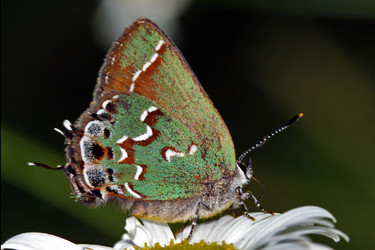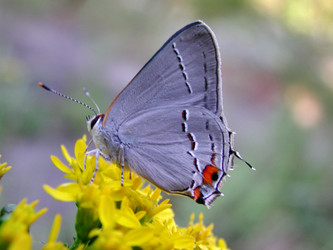Theclinae
Hairstreaks
Andrew V. Z. Brower


This tree diagram shows the relationships between several groups of organisms.
The root of the current tree connects the organisms featured in this tree to their containing group and the rest of the Tree of Life. The basal branching point in the tree represents the ancestor of the other groups in the tree. This ancestor diversified over time into several descendent subgroups, which are represented as internal nodes and terminal taxa to the right.

You can click on the root to travel down the Tree of Life all the way to the root of all Life, and you can click on the names of descendent subgroups to travel up the Tree of Life all the way to individual species.
For more information on ToL tree formatting, please see Interpreting the Tree or Classification. To learn more about phylogenetic trees, please visit our Phylogenetic Biology pages.
close boxIntroduction
The hairstreaks are an extremely diverse lycaenid subfamily, well-represented in all regions and particularly in the tropics. Many species possess "tails" on the apices of the hindwings that authors have hypothesized act as a false head, distracting the attention of predators away from the more vital body parts (see Robbins, 1980, 1981).
Discussion of Phylogenetic Relationships
The hypothesis of relationships among tribes is based on Eliot's (1973) intuitive phylogeny. Note that Eliot viewed Theclinae as a subfamily at that point (he demoted the group to a tribe in Corbet et al. 1992). According to R. K. Robbins (pers. comm., 2008), Eliot's 1992 reduction in rank of the hairstreaks, blues and coppers has not been adopted by most lycaenid researchers, and so these taxa are here ranked as a clade of subfamilies.
References
Corbet, A. S., Pendlebury, H. M. & Eliot, J. N. 1992 The butterflies of the Malay Peninsula. Kuala Lumpur: Malayan Nature Society.
Eliot, J. N. 1973 The higher classification of the Lycaenidae (Lepidoptera): a tentative arrangement. Bull. Br. Mus. Nat. Hist. (Ent.) 28, 371-505, 6 pls.
Robbins, R. K. 1980 The lycaenid "false head" hypothesis: historical review and quantitative analysis. J. Lepid. Soc. 34, 194-208.
Robbins, R. K. 1981 The "false head" hypothesis: predation and wing pattern variation of lycaenid butterflies. Amer. Nat. 118, 770-775.
Title Illustrations

| Location | Abbeville County, South Carolina, USA |
|---|---|
| Specimen Condition | Live Specimen |
| Source | juniper hairstreak |
| Source Collection | Flickr |
| Image Use |
 This media file is licensed under the Creative Commons Attribution-NonCommercial-NoDerivs License - Version 2.0. This media file is licensed under the Creative Commons Attribution-NonCommercial-NoDerivs License - Version 2.0.
|
| Copyright | © 2004 kim fleming |
| Scientific Name | Strymon melinus |
|---|---|
| Specimen Condition | Live Specimen |
| Source | Gray Hairstreak (Strymon melinus) |
| Source Collection | Flickr |
| Image Use |
 This media file is licensed under the Creative Commons Attribution-NonCommercial-NoDerivs License - Version 2.0. This media file is licensed under the Creative Commons Attribution-NonCommercial-NoDerivs License - Version 2.0.
|
| Copyright | © 2006 Lollie Dot Com |
About This Page
Andrew V. Z. Brower

Middle Tennessee State University, Murfreesboro, Tennessee, USA
Correspondence regarding this page should be directed to Andrew V. Z. Brower at
abrower@mtsu.edu
Page copyright © 2007 Andrew V. Z. Brower
 Page: Tree of Life
Theclinae . Hairstreaks.
Authored by
Andrew V. Z. Brower.
The TEXT of this page is licensed under the
Creative Commons Attribution License - Version 3.0. Note that images and other media
featured on this page are each governed by their own license, and they may or may not be available
for reuse. Click on an image or a media link to access the media data window, which provides the
relevant licensing information. For the general terms and conditions of ToL material reuse and
redistribution, please see the Tree of Life Copyright
Policies.
Page: Tree of Life
Theclinae . Hairstreaks.
Authored by
Andrew V. Z. Brower.
The TEXT of this page is licensed under the
Creative Commons Attribution License - Version 3.0. Note that images and other media
featured on this page are each governed by their own license, and they may or may not be available
for reuse. Click on an image or a media link to access the media data window, which provides the
relevant licensing information. For the general terms and conditions of ToL material reuse and
redistribution, please see the Tree of Life Copyright
Policies.
- First online 02 November 2007
- Content changed 24 April 2008
Citing this page:
Brower, Andrew V. Z. 2008. Theclinae . Hairstreaks. Version 24 April 2008 (under construction). http://tolweb.org/Theclinae/106372/2008.04.24 in The Tree of Life Web Project, http://tolweb.org/









 Go to quick links
Go to quick search
Go to navigation for this section of the ToL site
Go to detailed links for the ToL site
Go to quick links
Go to quick search
Go to navigation for this section of the ToL site
Go to detailed links for the ToL site